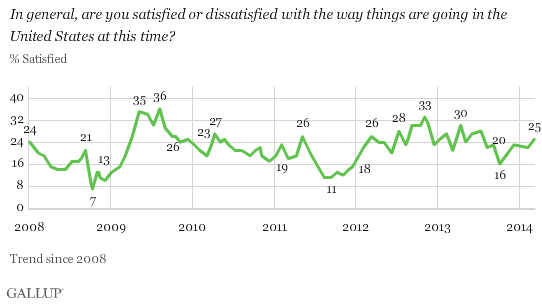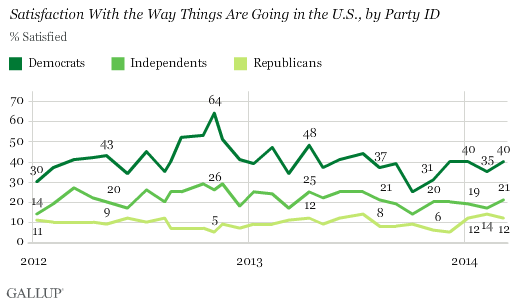WASHINGTON, D.C. -- One in four Americans (25%) are satisfied with the way things are going in the country at this time -- a low figure in an absolute sense but the highest since last July. Still, nearly three times as many Americans remain dissatisfied with how things are going in the U.S.

These results are from a March 6-9 Gallup poll, which show that Americans' satisfaction with the country's direction is gradually recovering from a recent low of 16% in October, during the federal government shutdown.
Satisfaction with the nation's direction has generally hovered in the 20s since early 2012. The highest satisfaction reading in recent years (33%) came in November 2012, just days before Barack Obama's re-election.
Gallup has asked this question since 1979. Satisfaction reached an all-time high of 71% in February 1999 amid the dot-com boom. The lowest reading (7%) was measured in October 2008 as the nation grappled with the early effects of the 2008 global financial crisis. Less than 40% of Americans have been satisfied with the way things are going in the U.S. since 2005, and satisfaction was last above the majority level in January 2004.
Satisfaction Varies by Political Identification
Americans' satisfaction levels with the way the country is going have historically varied according to the political party they identify with and the party of the president in office. This month, with a Democratic president in office, Democrats report the highest satisfaction levels (40%). Independents are half as likely to be satisfied with the country's direction (21%), and Republicans are the least satisfied (12%).

Bottom Line
Satisfaction with how things are going in the U.S., like other measures such as economic confidence, has recovered from its decline during the federal government shutdown. Still, with just 25% of the nation's residents satisfied with the way things are going, the nation as a whole remains deeply negative. These attitudes, coupled with continuing low congressional approval, may significantly influence the outcome of the midterm elections this November, although it is not clear exactly how voters will take out their frustrations, given that Congress is under divided party control.
Satisfaction was slightly lower (23%) in March 2010, the last congressional midterm year, when Republicans took control of the House, and only slightly higher in March 2006 (29%), the year Democrats took control. Satisfaction was significantly higher in March 2002 (61%), before the midterms in which Republicans gained control of the Senate and retained control of the House, reflecting in part the continuing rally effect that followed the 9/11 terrorist attacks the previous September.
Much of the explanation for low satisfaction is low economic confidence, which has been quite negative in recent years. Economic confidence could be even more influential in determining the future course of satisfaction because another shutdown seems unlikely in the near future.
Survey Methods
Results for this Gallup poll are based on telephone interviews conducted March 6-9, 2014, on the Gallup Daily tracking survey, with a random sample of 1,048 adults, aged 18 and older, living in all 50 U.S. states and the District of Columbia.
For results based on the total sample of national adults, the margin of sampling error is ±4 percentage points at the 95% confidence level.
Interviews are conducted with respondents on landline telephones and cellular phones, with interviews conducted in Spanish for respondents who are primarily Spanish-speaking. Each sample of national adults includes a minimum quota of 50% cellphone respondents and 50% landline respondents, with additional minimum quotas by time zone within region. Landline and cellular telephone numbers are selected using random-digit-dial methods. Landline respondents are chosen at random within each household on the basis of which member had the most recent birthday.
Samples are weighted to correct for unequal selection probability, nonresponse, and double coverage of landline and cell users in the two sampling frames. They are also weighted to match the national demographics of gender, age, race, Hispanic ethnicity, education, region, population density, and phone status (cellphone only/landline only/both, and cellphone mostly). Demographic weighting targets are based on the most recent Current Population Survey figures for the aged 18 and older U.S. population. Phone status targets are based on the most recent National Health Interview Survey. Population density targets are based on the most recent U.S. census. All reported margins of sampling error include the computed design effects for weighting.
In addition to sampling error, question wording and practical difficulties in conducting surveys can introduce error or bias into the findings of public opinion polls.
View survey methodology, complete question responses, and trends.
For more details on Gallup's polling methodology, visit www.gallup.com.
